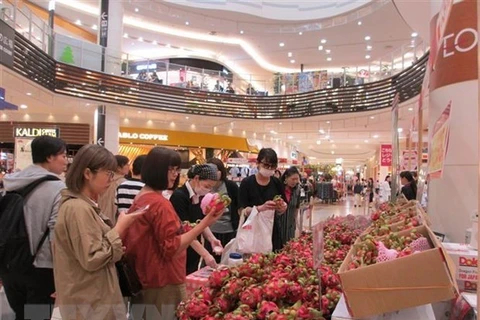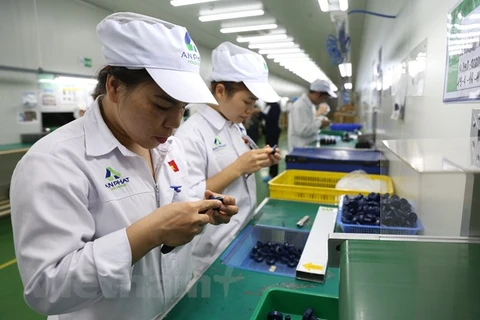 Deputy Minister of Industry and Trade Do Thang Hai addresses the forum on enhancing the competitiveness of Vietnamese products (Photo: VietnamPlus)
Deputy Minister of Industry and Trade Do Thang Hai addresses the forum on enhancing the competitiveness of Vietnamese products (Photo: VietnamPlus) Hanoi (VNA) – The development of the Vietnamese “eagles” is a key task in winning the market share amid new-generation free trade agreements, heard a forum held by the Ministry of Industry and Trade (MoIT) in Hanoi on October 29.
Experts and business leaders met to discuss measures to enhance the competitiveness of Vietnamese products during the global COVID-19 pandemic.
Vietnamese products are becoming more attractive on the market and winning increasing trust from consumers, while the coverage of “Made in Vietnam” products is becoming broader, affirming the position of the products on the domestic market.
However, amid the current intensive and extensive integration and impacts of the COVID-19 pandemic, changes have been seen in supply chains and the competitiveness of businesses, especially small- and medium-sized enterprises (SMEs).
Facing risks of direct competition
The results of a survey conducted by the Institute for Public Opinion Studies under the Party Central Committee’s Commission for Information and Education in 2019 showed that 88 percent of consumers said that they were interested in the movement of Vietnamese people prioritising the use of Vietnamese products, while 67 percent told themselves to prioritise Vietnamese goods while shopping, and 52 percent said that they advised their relatives and friends to use Vietnamese products.
Meanwhile, the ratio of Vietnamese products sold in distribution channels has been high at 90-93 percent in Co.opmart, 90-95 percent in Satra, 96 percent in Vinmart, 95 percent in Vissan and 95 percent in Hapro. In foreign-owned distribution channels, the ratio has also kept at 65-96 percent.
Deputy Minister of Industry and Trade Do Thang Hai said that the signing of free trade agreements (FTA) has helped expand and diversify the import-export markets for Vietnam.
The financial service market has been developed with the involvement of many foreign investors, while the mechanisms and policies in the field have been completed to meet the demand of integration and commitments the country has made in FTAs, he said.
Hai noted that, together with the joining of the WTO in 2007, the involvement in FTAs has contributed to increasing Vietnam’s GDP by 300 percent and raising import-export revenue by 350 percent.
According to Le Viet Nga, deputy head of the Domestic Market Department under the MoIT, the national culture and regional specialties have been optimised to approach domestic and foreign consumers through trade fairs, supply-demand connection events and the “One Commune-One Product” (OCOP) Programme.
Currently, 2,049 OCOP products from 45 cities and provinces have been rated with three stars and above, including 43 products having high potential of receiving five stars. At the end of 2020, more than 3,800 OCOP products are expected to be standardised, she said.
However, Nga pointed out that the engagement in FTAs, especially new-generation deals such as the EU-Vietnam FTA and the Comprehensive and Progressive Agreement for Trans-Pacific Partnership (CPTPP) has brought about shopping chances for consumers, but also put challenges on Vietnamese products.
The shortcomings in production scale and market experience are one of the weaknesses of Vietnamese firms, she said.
Statistics from the Ministry of Planning and Investment showed that Vietnam has nearly 800,000 operating businesses, the majority of which are small and medium in size.
Tran Duy Dong, Deputy Minister of Planning and Investment, said that the ratio of medium and big firms is too low at about 3 percent, leaving a big hole in the business structure.
Due to their modest size, Vietnamese firms face difficulties in attracting investment, reforming technology, expanding scale and improving their management capacity, Dong said.
Creating new competition motivation
The existing shortcomings have led to a few numbers of domestically-funded businesses engaging in the value chains of leading domestic businesses and foreign-invested companies.
Citing the statistics of the LinkSME project, MoIT leaders said that businesses from Japan – one of the biggest investors of Vietnam – buy about 32.4 percent of input products and services from local suppliers. The figure is much lower than that by Japanese-funded firms in China (67.8 percent), Thailand (57.1 percent) and Indonesia (40.5 percent).
Moreover, the World Bank report also clarified that the connections between domestic and foreign private companies or between small and big enterprises are limited.
For example, for 20 major automobile assembly companies in Vietnam, there are only 81 suppliers at level one and 145 at levels two and three. But Thailand has only 16 big automobile assembling firms but the country has 690 suppliers at level 1 and 1,700 at levels two and three.
Associate Prof. Dr. Tran Dinh Thien, a member of the Government Advisory Board, held that it is necessary to roll out urgent solutions to help businesses to adapt to the “new normal” situation by building the foundations for the market economy, which are input markets.
Mentioning the establishment of a new mindset and approach to the “invitation of eagles” and “building nest for eagles to lay eggs”, Thien said that it is necessary to develop the force of Vietnamese businesses into a national action programme and strategy which is placed in the top priority, in which, the growing of “Vietnamese national eagles” is the key factor.
Thien said that the national startup should be re-designed to match the requirements of the era, thus rapidly changing blood for the economy. He also stressed the need to build an institution system matching the digital, high technology and knowledge-based economy.
In order to create new motivation for the stronger engagement of small and medium enterprises in value chains and linkages, Deputy Minister of Planning and Investment Tran Duy Dong said that over the years, the Ministry of Planning and Investment has coordinated with ministries, sectors and localities to promote programmes to support firms in market, production and business connectivity, trademark development and finance. Besides, the ministry has implemented a USAID-funded Linkages for Small and Medium Enterprises (LinkSME) Project with an aim to help businesses enhance their competitiveness and involve deeper in the global production and value chains.
One of the major objectives of the project is to enhance relations between Vietnamese SMEs and businesses at the top of the supply chain and improve the capacity for the firm to join regional and global supply chains. In 2023, the project is expected to support the formation of 52 linkages./.
























